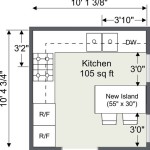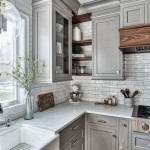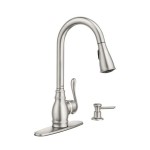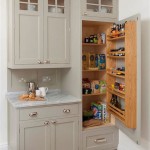The Importance of a Kitchen With Hood Over Stove
A kitchen equipped with a hood over the stove is a cornerstone of modern homes, providing a vital function that goes beyond mere aesthetics. The inclusion of a range hood, or cooker hood, directly above the cooking surface is a proactive measure contributing significantly to indoor air quality, kitchen hygiene, and overall home safety. While often viewed as an optional appliance, the benefits derived from strategically placed and appropriately powered range hoods provide justifications for its integration into kitchen designs, regardless of the size or style of the space.
The primary purpose of a kitchen hood is to remove airborne contaminants generated during the cooking process. These contaminants include grease, smoke, steam, odors, and combustion byproducts, all of which contribute to indoor air pollution. Without adequate ventilation through a range hood, these particles can accumulate on kitchen surfaces, leading to sticky residues, unpleasant odors, and potential health hazards. The accumulation of grease, in particular, is a fire risk and can attract pests. The effectiveness of a kitchen hood in mitigating these issues is not only beneficial for immediate comfort but also plays a significant role in preserving the cleanliness and longevity of the kitchen environment.
The functionality and efficiency of a kitchen hood are determined by several factors, including its design, filtration system, fan power, and installation method. Understanding these elements is crucial for selecting a hood that effectively addresses the specific needs of a given kitchen. Variations in cooking styles, frequency of use, and kitchen layout necessitate careful consideration when choosing a range hood to ensure optimal performance and maintain a healthy and comfortable living space.
Enhancing Indoor Air Quality
The presence of a range hood significantly improves indoor air quality by actively removing pollutants released during cooking. The cooking process, depending on the method and ingredients, can generate a cocktail of airborne particles and gases. Frying, sautéing, and grilling, for example, produce significant amounts of grease-laden smoke. Similarly, boiling water or simmering sauces release steam, contributing to increased humidity levels. These contaminants, if not properly ventilated, can linger in the air, posing potential risks to respiratory health. Moreover, gas stoves emit combustion byproducts, such as nitrogen dioxide and carbon monoxide, which can be particularly harmful in poorly ventilated spaces.
Range hoods employ a combination of filtration and exhaust mechanisms to combat these issues. Filters, typically made of mesh or charcoal, capture grease and other particulates, preventing them from circulating throughout the kitchen and the rest of the home. The exhaust fan then draws the filtered air and any remaining contaminants out of the kitchen, either through a duct system that vents to the outside or through a recirculation system that filters the air and returns it to the kitchen. While ducted range hoods generally provide superior performance in terms of contaminant removal, recirculating models offer a viable alternative for kitchens where ductwork is impractical or impossible.
The improvement in air quality achieved by using a range hood is particularly relevant for individuals with respiratory sensitivities, such as asthma or allergies. The removal of airborne irritants can help to alleviate symptoms and create a more comfortable and healthier living environment. Furthermore, reducing the accumulation of grease and other particles minimizes the potential for mold growth, which can also trigger allergic reactions and respiratory problems. Therefore, the installation and consistent use of a range hood are essential components of a comprehensive strategy for maintaining healthy indoor air quality.
Maintaining Kitchen Hygiene
A kitchen hood plays a crucial role in maintaining a hygienic cooking environment by preventing the buildup of grease, grime, and odors. The persistent accumulation of grease on surfaces, such as countertops, cabinets, and walls, creates a breeding ground for bacteria and attracts pests. This not only compromises the cleanliness of the kitchen but also presents potential health hazards. Additionally, lingering cooking odors can permeate fabrics and other porous materials, making it difficult to maintain a fresh and pleasant atmosphere.
By capturing grease and other airborne particles before they settle on surfaces, a range hood significantly reduces the need for frequent and intensive cleaning. This saves time and effort while also minimizing the use of harsh cleaning chemicals. Regular cleaning of the range hood’s filters is essential for maintaining its effectiveness. Depending on the frequency of cooking, filters should be cleaned or replaced periodically to ensure optimal grease capture and airflow. Some range hood models feature dishwasher-safe filters, simplifying the cleaning process.
The reduction in grease buildup also helps to prolong the lifespan of kitchen cabinets and other fixtures. The corrosive nature of grease can damage finishes and cause discoloration over time. By preventing grease from settling on these surfaces, a range hood helps to preserve their appearance and structural integrity. Therefore, the investment in a quality range hood represents a proactive measure in maintaining a clean, hygienic, and aesthetically pleasing kitchen environment.
Enhancing Home Safety
A key safety benefit of a kitchen hood is the reduction of fire risk. The accumulation of grease in the kitchen, particularly around the stove area, is a significant fire hazard. Grease is highly flammable, and even small amounts can ignite quickly and spread rapidly. A range hood helps to mitigate this risk by capturing grease particles before they settle on surrounding surfaces, including the stove itself, backsplashes, and overhead cabinets.
In the event of a cooking-related fire, a range hood can also help to contain the flames and prevent them from spreading to other areas of the kitchen or the house. By drawing smoke and heat away from the cooking area, the hood can provide valuable time for individuals to react and extinguish the fire before it escalates. Some range hood models are equipped with fire suppression systems that automatically activate in the event of a fire, further enhancing safety.
Furthermore, a range hood can improve visibility while cooking by removing steam and smoke that can obstruct the cook's view. Clear visibility is essential for preventing accidents and ensuring that food is cooked safely and properly. The improved visibility also contributes to a more comfortable and enjoyable cooking experience. Therefore, the integration of a range hood into the kitchen design is not only a matter of convenience but also a crucial safety measure that protects both the home and its occupants.
In addition to the direct benefits of improved air quality, hygiene, and safety, a kitchen with a hood over the stove also contributes to the overall value of a home. A well-ventilated kitchen is a desirable feature for potential buyers, and the presence of a quality range hood can enhance the appeal of the property. Furthermore, the prevention of long-term damage caused by grease and other contaminants can save homeowners money on repairs and replacements in the long run. The considerations of appropriate hood size, fan power (measured in cubic feet per minute/CFM), and ducting (if applicable) are essential for optimal performance. Choosing a hood slightly larger than the stove width is generally recommended.
The selection of a range hood should be based on a comprehensive assessment of the kitchen's specific needs and characteristics. Factors such as the type of stove (gas or electric), frequency of cooking, cooking styles, kitchen size, and available ventilation infrastructure should all be taken into account. Consulting with a qualified appliance professional or contractor can provide valuable guidance in selecting the most appropriate range hood for a given kitchen and ensure proper installation and functionality. Proper installation is crucial for ensuring the hood operates efficiently and effectively removes contaminants from the air. This often involves ensuring proper ducting is installed to vent the air outside, maintaining airflow while minimizing noise.
The integration of a kitchen hood over the stove is a multifaceted investment that yields significant returns in terms of health, hygiene, safety, and property value. By actively removing airborne contaminants, the hood contributes to a healthier and more comfortable living environment. Its ability to prevent grease buildup helps to maintain a clean and hygienic kitchen, while its role in reducing fire risk enhances overall home safety. Therefore, the inclusion of a properly selected and installed range hood is an essential component of a well-designed and functional kitchen.
:strip_icc()/102182173-aa40bee4dcac4216b9dfcf31aa250565.jpg?strip=all)
25 Range Hood Ideas And Styles From Modern Farmhouse To Eclectic

Diy Kitchen Range Hood Shades Of Blue Interiors
:strip_icc()/102035207-3844e283900248e1bbee8e125ab40fdb.jpg?strip=all)
25 Range Hood Ideas And Styles From Modern Farmhouse To Eclectic

Stainless Steel Vent Hood In Front Of Kitchen Windows Transitional

Why You Need A Range Hood Plus Essential Gui For Selecting One

Covered Range Hood Ideas Kitchen Inspiration The Inspired Room
How To Choose The Best Range Hood For Your Gas Stove

Fabulous Cooking Area Great Stone Work Kitchen Design White Traditional Pictures

Kitchen Makeover With Island Vent Hood Custom Made Products

Kitchen Island Hood Design Ideas








